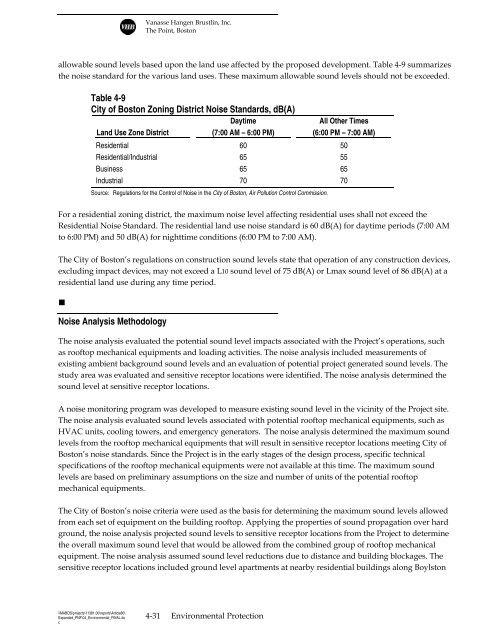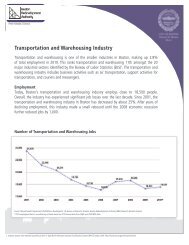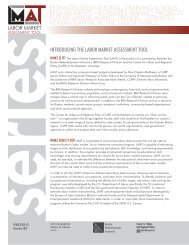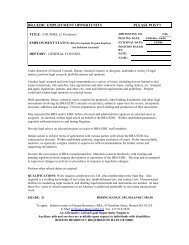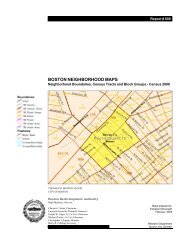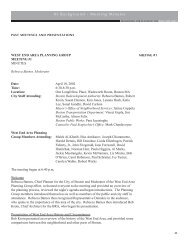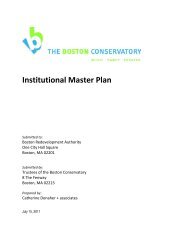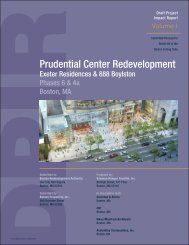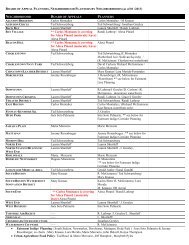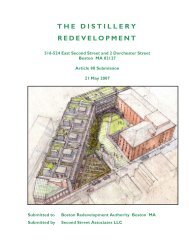point cover jan 13 - Boston Redevelopment Authority
point cover jan 13 - Boston Redevelopment Authority
point cover jan 13 - Boston Redevelopment Authority
Create successful ePaper yourself
Turn your PDF publications into a flip-book with our unique Google optimized e-Paper software.
\\MABOS\projects\1<strong>13</strong>81.00\reports\Article80\<br />
Expanded_PNF\04_Environmental_FINAL.do<br />
c<br />
Vanasse Hangen Brustlin, Inc.<br />
The Point, <strong>Boston</strong><br />
allowable sound levels based upon the land use affected by the proposed development. Table 4-9 summarizes<br />
the noise standard for the various land uses. These maximum allowable sound levels should not be exceeded.<br />
Table 4-9<br />
City of <strong>Boston</strong> Zoning District Noise Standards, dB(A)<br />
Daytime<br />
All Other Times<br />
Land Use Zone District<br />
(7:00 AM – 6:00 PM)<br />
(6:00 PM – 7:00 AM)<br />
Residential 60 50<br />
Residential/Industrial 65 55<br />
Business 65 65<br />
Industrial 70 70<br />
Source: Regulations for the Control of Noise in the City of <strong>Boston</strong>, Air Pollution Control Commission.<br />
For a residential zoning district, the maximum noise level affecting residential uses shall not exceed the<br />
Residential Noise Standard. The residential land use noise standard is 60 dB(A) for daytime periods (7:00 AM<br />
to 6:00 PM) and 50 dB(A) for nighttime conditions (6:00 PM to 7:00 AM).<br />
The City of <strong>Boston</strong>’s regulations on construction sound levels state that operation of any construction devices,<br />
excluding impact devices, may not exceed a L10 sound level of 75 dB(A) or Lmax sound level of 86 dB(A) at a<br />
residential land use during any time period.<br />
<br />
Noise Analysis Methodology<br />
The noise analysis evaluated the potential sound level impacts associated with the Project’s operations, such<br />
as rooftop mechanical equipments and loading activities. The noise analysis included measurements of<br />
existing ambient background sound levels and an evaluation of potential project generated sound levels. The<br />
study area was evaluated and sensitive receptor locations were identified. The noise analysis determined the<br />
sound level at sensitive receptor locations.<br />
A noise monitoring program was developed to measure existing sound level in the vicinity of the Project site.<br />
The noise analysis evaluated sound levels associated with potential rooftop mechanical equipments, such as<br />
HVAC units, cooling towers, and emergency generators. The noise analysis determined the maximum sound<br />
levels from the rooftop mechanical equipments that will result in sensitive receptor locations meeting City of<br />
<strong>Boston</strong>’s noise standards. Since the Project is in the early stages of the design process, specific technical<br />
specifications of the rooftop mechanical equipments were not available at this time. The maximum sound<br />
levels are based on preliminary assumptions on the size and number of units of the potential rooftop<br />
mechanical equipments.<br />
The City of <strong>Boston</strong>’s noise criteria were used as the basis for determining the maximum sound levels allowed<br />
from each set of equipment on the building rooftop. Applying the properties of sound propagation over hard<br />
ground, the noise analysis projected sound levels to sensitive receptor locations from the Project to determine<br />
the overall maximum sound level that would be allowed from the combined group of rooftop mechanical<br />
equipment. The noise analysis assumed sound level reductions due to distance and building blockages. The<br />
sensitive receptor locations included ground level apartments at nearby residential buildings along Boylston<br />
4-31 Environmental Protection


